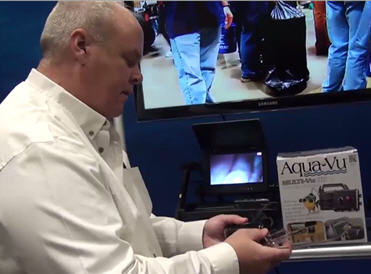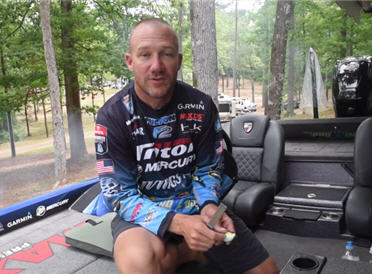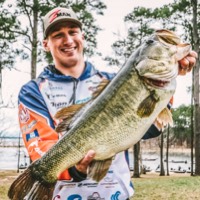- BassEdge.com - Pursue Your Passion
Bassmaster Pro Josh Bertrand Weighs in on What Size Worm Sinker to Use

New Aqua-Vu HD 700 i Underwater Camera
February 15, 2017
Keep This Fishing Tool in Your Boat
March 1, 2017Article by: Jonathan LePera, for BassProShops1Source
When largemouth bass are tucked into cover in 5-feet of water or less, nothing beats swinging back on a trophy largemouth bass after seeing your line twitch ever so slightly after pitching your Texas-rigged bait or flipping jig into the sweet spot. That can only happen if you pair your bait with the proper sized weight so that your rig can penetrate cover and fall properly to trigger those key bites. Bassmaster Elite Pro Josh makes a few weighty decisions and weighs in on what size worm sinker to use.
 |
| Bass Pro Shops XPS Tungsten worm weight |
A Starting Point: Determine the Weight of the Sinker
The density of the cover ultimately determines the weight of the sinker you should rig up. Bertrand starts off with a 5/16-ounce Bass Pro Shops XPS Tungsten worm weight or the XPS Tungsten flippin weight as they are a versatile weight that allows him to penetrate sparse cover, light grass, and dissect docks and wood. It also works perfectly when Bertrand needs to skip a bait way up under cover.
Lighter Rigs for Lethargic Fish
“Whenever the fish are lethargic, and during the colder months, you don’t want to overpower them with something that falls too quick. You aren’t looking for a reaction bite,” Bertrand said. Selecting an offering that falls slower when the water is colder and registers between 40- and 50-degrees allows bass the necessary time to go to the bait and eat it.
 |
| Bass Pro Shops XPS Tungsten flippin weight |
Especially during the spawn, or immediately thereafter, is not the time to pitch out a bait that falls fast with a heavy weight. “When you have a lot of cruising fish that aren’t thinking as much about feeding as they are about spawning,” he said. In post-frontal situations which are known for creating finicky appetites, he’ll sooner downsize his bait or fish slower before lightening up his weight.
![]() Test your bass spawing IQ, take the quiz and find out – LINK
Test your bass spawing IQ, take the quiz and find out – LINK
Targeting fish in super shallow water is another good reason to lighten up.
Probably the best time to lighten your presentation when pitching and flipping in really dirty water. “If you have chocolate milk, you can’t have a 1.5-ounce weight that can fall by their face before they can see it or feel it,” Bertrand started. “You need to slow down and give them a chance to see it in the strike zone.”
Agressive Fish Requires Heavy Decisions
When targeting sparse cover and the fish are aggressive, he’ll use a ½ or 9/16-ounce to create a reaction strike especially when the water temps are up over 75 degrees.
“If you are in really warm water, especially during the summer, and looking for a reaction strike, I’ve flipped as heavy as 9/16 to try to get a nice fast fall and get a reaction strike,” he started. “The depth is critical too- the bait needs to get to the bottom.”
Shake the Bait Through? Not an Efficient Approach
Bertrand will never rig a lighter weight with the intention of shaking it through the cover to achieve a slower fall. It isn’t an efficient approach as more time is lost trying to get the presentation just right. Instead, He’ll use a heavier weight to penetrate the cover but he’ll control the rate of fall with his thumb.
 |
| Berkley Fusion 19 Heavy Cover hook |
Creative Rigging
Especially when fishing in Florida, Bertrand will rig a lighter weight with a heavier bait especially when swimming baits around cover. It’s not uncommon for him to rig larger baits with a Berkley Fusion 19 Heavy Cover hook. Rigging up a 1/16 to 3/16-ounce weights definitely has its place. When fishing in the North East, he’ll utilize lighter weighted baits that he’ll fish around, and above, grass. “You’ll literally swim it over the grass or just barely kind of fishing it through but not letting it bury down in it,” he said.
Fishing Weights by Season
During the Spring when faced with cold water under 55-degrees, weights ranging from 1/8- to 5/16-ounce works best. Once the warmer water temps of summer arrive and through the early part of fall when fish are still aggressive, he’ll start with a 5/16-ounce weight and upsize when the cover dictates it. Once the cold nights of fall start to lower the water temperatures and into winter, he’ll revert to the same weights used during the spring. Ultimately, the angler is going to have to analyse each situation and the factors involved to best determine the most efficient weight to use while eliciting bites.
 |
| Abu Garcia Revo ALX fishing reel |
Gear Talk
Bertrand starts off pitching and flipping with 20-pound Berkley Trilene 100% Fluorocarbon Professional Grade Fishing Line but will use the popular Berkley Trilene Professional Grade Tracer Braid when possible. A 7’6 heavy-action Abu Garcia Villain rod is required to haul bass out of nasty cover paired with an Abu Garcia Revo ALX reel with 8:1 gearing provides the necessary speed and power to wind in big bass.
The Berkley Havoc Pit Boss softbait is rigged on a 4/0 Berkley Fusion 18 Heavy Cover hook is his confidence bait. He’ll keep his color choices simple using black/blue in dirty water, green pumpkin when the water is clear, and candy grass when largemouth are feeding on bluegill. He’ll even dip the tails in chartreuse fish attractant dye to best “match-the-hatch”.
 |
| Bass Pro Shops Enticer Pro Series Rattling Jig |
 |
| Berkley Chigger Craw powerbait |


